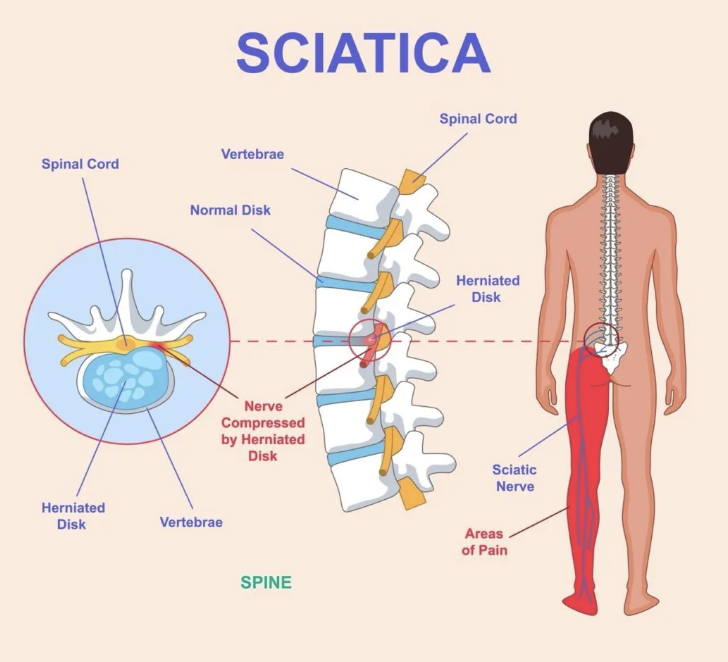Decoding Sciatica Symptoms: A Guide to Nerve Pain in Buffalo, NY ⚡
That sharp, shooting pain that radiates from your lower back down your leg is a distinctive and often debilitating experience. It's a type of discomfort that’s difficult to ignore and can dramatically alter your daily life. This specific pattern of pain is known as sciatica. For many in Buffalo, NY, living with sciatica symptoms can feel confusing and unpredictable. Understanding exactly what these symptoms are, why they occur, and how to recognize them is the critical first step toward getting to the root of the problem and finding relief in Western New York.
The Sciatic Nerve: A Pathway of Sensation and Pain 🧠
To understand the symptoms of sciatica, it's helpful to know a little about the nerve itself. The sciatic nerve is the longest and largest nerve in the human body. It’s formed by several nerve roots from the lower spine, running from the lower back, through the buttock, and down the back of each leg, eventually branching to the foot and toes. Its primary role is to transmit sensation and motor function to the legs.
Sciatica is not a diagnosis on its own; rather, it is a symptom of an underlying condition that is compressing or irritating the sciatic nerve or one of its nerve roots. This compression is what causes the characteristic pain and other sensations along its pathway.
The Hallmark Symptoms of Sciatica 🦵
The symptoms of sciatica are often so distinct that they are hard to mistake for other types of back or leg pain. They are typically unilateral, meaning they affect only one side of the body at a time.
- Radiating Pain: This is the most classic symptom. The pain typically originates in the lower back or buttock and travels, or radiates, down the back of the leg. This radiating pain can be described in a number of ways:
- A sharp, shooting sensation that feels like an electric shock.
- A deep, burning pain that follows a specific path.
- A constant, dull ache that can be difficult to ignore.The pain often extends below the knee and can reach the calf, ankle, or foot. For those in Buffalo, this pain can be particularly frustrating when navigating stairs or walking on uneven ground.
- Numbness and Tingling: Alongside the pain, you might experience altered sensations in the affected leg or foot. This is often described as a feeling of "pins and needles," or a complete loss of sensation, known as numbness. This happens because the nerve is being compressed, which interferes with its ability to transmit signals properly.
- Weakness: In more severe cases, nerve compression can interfere with the signals that control muscle movement. This can lead to muscle weakness in the leg or foot. You may notice that you have trouble lifting your foot, a condition known as foot drop, or that you are unable to move your toes properly.
- Pain That Worsens with Movement: The pain is often exacerbated by certain actions. For example, sitting for long periods, standing for an extended time, or twisting your spine can increase the pressure on the nerve. Even seemingly simple actions like coughing or sneezing can send a jolt of pain down the leg.
- Sleep Disruption: Sciatic pain can be particularly severe at night, making it difficult to find a comfortable position. Lying down can sometimes increase pressure on the nerve, leading to constant tossing and turning and a lack of restorative sleep.
Less Common or Co-occurring Symptoms ⚠️
While the symptoms above are the most common, sciatica can also present with other signs or be accompanied by other discomforts.
- Lower Back Pain: While sciatica's defining characteristic is the pain that radiates down the leg, the underlying cause is often a problem in the lower back. Therefore, it's very common for people with sciatica to also experience back pain, though the leg pain is usually the more dominant and debilitating symptom.
- Difficulty with Bladder or Bowel Control: This is a rare and serious symptom that should never be ignored. If sciatica is accompanied by new-onset weakness in both legs, numbness in the groin area, or a sudden loss of bladder or bowel control, it may be a sign of a condition called cauda equina syndrome. This is a medical emergency that requires immediate medical attention.
The Daily Impact of Sciatica Symptoms in Buffalo, NY 😫
Living with the symptoms of sciatica can have a profound impact on daily life for residents of Buffalo. The pain and unpredictability can make even simple tasks seem daunting.
- Mobility Challenges: The radiating pain and weakness can make it difficult to walk, stand, or climb stairs. This can limit your ability to enjoy local parks or even just get around your home.
- Work and Hobbies: Sitting at a desk for long periods or performing physical labor can be excruciating. The pain can make it difficult to pursue hobbies or engage in recreational activities, leading to a more sedentary lifestyle.
- Emotional Toll: The constant pain and fear of a sudden flare-up can take a significant toll on your mental and emotional well-being. This can lead to frustration, anxiety, and a feeling of helplessness.
- Sleep Deprivation: The inability to get comfortable at night can lead to a cycle of pain and fatigue that affects every aspect of your life.
- Buffalo-Specific Challenges: Navigating the city's terrain, driving in traffic, or dealing with cold weather can be particularly challenging with sciatic pain, as these factors can often aggravate symptoms.
Don't Let Sciatica Dictate Your Life! 🌟
Sciatica symptoms are a clear signal from your body that something is wrong. They are not something to be ignored or simply endured. Understanding the specific nature of this pain is the first step toward finding a path to relief. For those in Buffalo, NY, dealing with the frustrating and debilitating symptoms of sciatica, remember that getting an accurate diagnosis is paramount.


